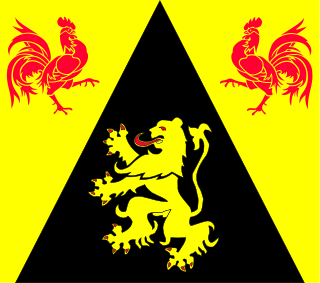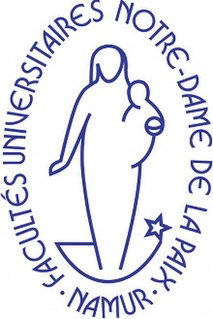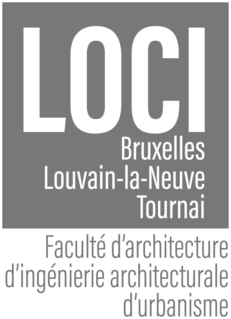
Walloon Brabant is a province of Wallonia and Belgium. It borders on the province of Flemish Brabant and the provinces of Liège, Namur and Hainaut (Wallonia). Its capital and largest city is Wavre.

Ottignies-Louvain-la-Neuve is a city and municipality of Wallonia located in the Belgian province of Walloon Brabant. On January 1, 2006, Ottignies-Louvain-la-Neuve had a total population of 29,521. The total area is 32.96 km² which gives a population density of 896 inhabitants per km².

Louvain-la-Neuve is a planned village in the municipality of Ottignies-Louvain-la-Neuve, Wallonia, Belgium, situated 30 km southeast of Brussels, in the province of Walloon Brabant. The village was built to house the Université catholique de Louvain (UCLouvain) which owns its entire territory; following the linguistic quarrels that took place in Belgium during the 1960s, and Flemish claims of discrimination at the Catholic University of Leuven, the institution was split into the Dutch language Katholieke Universiteit te Leuven which remained in Leuven, and the Université catholique de Louvain.

The Université catholique de Louvain is Belgium's largest French-speaking university. It is located in Louvain-la-Neuve, which was expressly built to house the university, and Brussels, Charleroi, Mons, Tournai and Namur. Since September 2018, the university has used the branding UCLouvain, replacing the acronym UCL, following a merger with Saint-Louis University, Brussels.

UCLouvain FUCaM Mons is a satellite campus of the University of Louvain (UCLouvain) in Mons, Wallonia, Belgium founded in 1896. Until 2011, it was an independent institution known as the Catholic university of Mons. Its official language is French.

The University of Namur or Université de Namur, in Namur (Belgium), is a Jesuit, Catholic private university in the French Community of Belgium. Both teaching and research are carried out in six Faculties or university level schools in the fields of:

The Cliniques universitaires Saint-Luc is a non-profit academic hospital of the University of Louvain (UCLouvain), located on the university campus of UCLouvain Bruxelles Woluwe in Woluwe-Saint-Lambert, Brussels, Belgium. The hospital opened on 23 August 1976, moving from Leuven to Brussels.
The Aéropole Science Park is a business incubator and science park located in Gosselies, Charleroi, Belgium, nearby the Brussels South Charleroi Airport.
The Initialis Science Park is a business incubator and science park located in Mons in the province of Hainaut, Wallonia (Belgium). The science park is associated with the two universities present in Mons; the University of Mons and the University of Louvain. The science park comprises two technopoles: Multitel, which groups telecommunications, signal and image processing and Materia Nova, which groups research and development on new materials such a ceramics.
Science and technology in Wallonia, the southern region of Belgium (Europe), is well developed with the presence of several universities and research institutes.
Orchestre symphonique des Étudiants de Louvain-la-Neuve (OSEL) is a Belgian symphony orchestra based in Louvain-la-Neuve, Wallonie, and mainly composed of students from the University of Louvain (UCLouvain).

UCLouvain Bruxelles Woluwe, also known as Louvain-en-Woluwe or Alma, is a campus of the University of Louvain in Brussels, Belgium. The campus, built in the 1970s following the Leuven crisis, houses the Faculties of Medicine and Dentistry, Pharmacy and Biomedical Sciences and of Public Health, the Cliniques universitaires Saint-Luc, the university's main academic hospital, as well as many other institutions of higher education and a vast sports complex.

The Musée L or Musée universitaire de Louvain, French for: Louvain University Museum, is a Belgian university museum of the University of Louvain (UCLouvain) located in Louvain-la-Neuve, Walloon Brabant, Belgium.

UCLouvain Charleroi is a campus of the University of Louvain in Charleroi, Belgium. Consisting of 3 faculties and a series of research centers and institutes, UCLouvain Charleroi consists of the Maison Georges Lemaître, in the center of the city, and a branch in Montignies-sur-Sambre.

The Faculty of Economic, Social and Political Sciences and Communication (ESPO) is a faculty of the University of Louvain, located on the campuses of Louvain-la-Neuve, FUCaM Mons and UCLouvain Charleroi. It originates in the School of Political and Social Sciences founded by Jules Van den Heuvel in Louvain in 1892. With over 6000 students, it is UCLouvain's largest faculty.

The Aula Magna is a postmodern building of the University of Louvain located in Louvain-la-Neuve, a section of the Belgian city of Ottignies-Louvain-la-Neuve, in Walloon Brabant. It holds one of the country's largest auditoria, with a maximum capacity of 1050 seats, and Wallonia's largest stage. Inaugurated in 2001, the complex was designed by Philippe Samyn.

The Louvain-la-Neuve Cyclotron is a brutalist architectural complex of the University of Louvain built from 1970 to 1972 in Louvain-la-Neuve, Walloon Brabant, Belgium, notably holding UCLouvain's CYCLONE particle accelerators. It is the first building completed by the university when it moved following the Leuven crisis and was the largest cyclotron in Europe at the time of its construction. The Louvain Cyclotron can also refer to Belgium's first cyclotron built in Louvain (Leuven) in 1947, which was replaced by the Louvain-la-Neuve center.

The Louvain School of Engineering or École polytechnique de Louvain (EPL) is a faculty of the University of Louvain, Belgium, founded in 1864. Known as the Faculty of Applied Sciences prior to 2008, it currently operates on the campuses of Louvain-la-Neuve and UCLouvain Charleroi.

The Faculty of Architecture, Architectural Engineering and Urban Planning, often called LOCI, is the 14th faculty of the University of Louvain, Belgium. It became an independent faculty in 2009, with the merger of three institutes founded between 1867 and 1882, and is active in Brussels (Saint-Gilles), Tournai and Louvain-la-Neuve.

Biéreau Farm is an old Brabantine farm now turned into a cultural and musical centre. It is located in Louvain-la-Neuve, part of the municipality Ottignies-Louvain-la-Neuve, in the province Walloon Brabant in Belgium.













